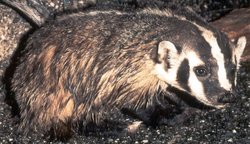Badger
|
|
| Badgers | ||||||||||||
|---|---|---|---|---|---|---|---|---|---|---|---|---|
 American Badger | ||||||||||||
| Scientific classification | ||||||||||||
| ||||||||||||
| Suborders | ||||||||||||
Badger is the common name for any animal of three subfamilies, which belong to the family Mustelidae: the same mammal family as the ferrets, the weasels, the otters, and several other types of carnivore. There are 9 species of badger, in three subfamilies: Melinae (the Eurasian badgers), Mellivorinae, (the Ratel or Honey Badger), and Taxidinae (the American Badger). The name is possibly derived from the word badge, on account of the marks on the head; or it may be identical with the term noted below, the French blaireau being used in both senses. Typical badgers (Meles, Arctonyx, Taxidea and Mellivora species) are short-legged and heavy-set. The lower jaw is articulated to the upper, by means of a transverse condyle firmly locked into a long cavity of the cranium, so that dislocation of the jaw is all but impossible. This enables the badger to maintain its hold with the utmost tenacity.
The collective name for a group of badgers is a "cete".
Many years ago, people believed all sorts of things about badgers. These old sayings and stories (folklore) seem very strange today!
For instance, people used to say that badgers had legs that were shorter on one side than the other. This was supposed to be because badgers often walked on sloping ground on the sides of hills!
Some people thought that badgers could bring bad luck. This rhyme dates from about 200 years ago:
Should one hear a badger call, And then an ullot cry, Make thy peace with God, good soul, For thou shall shortly die. So, according to this bit of folklore, if you hear a badger call, then hear an "Ullot" (an owl) hoot, you are not long for this world!
| Contents |
Taxidinae subfamily
American Badger (Taxidea taxus)
The American Badger ranges over the greater part of the western and central United States as well as northern Mexico and southern Canada. Like the Eurasian badgers it is a powerful digger, but some of its behaviors differ from those of its relatives.
T. taxus is more carnivorous than the Meles species, and does not inhabit a permanent sett, or hole. Unless it is courting or rearing young, the American Badger lives apart from others of its kind. It hunts, wanders and sleeps in temporary burrows within a given territory, often inhabiting holes excavated by other animals and sometimes even sharing space with the original tenants.
Badgers and Humans
The badger's skill at digging has led to folk beliefs that the animal's paws give good luck in childbirth. The Pueblo people consider the badger great healers and believe them to be intimately connected to their shamans. Japanese legends include shapeshifting badgers.
The badger does not usually seek to attack, but, when driven to bay, its great muscular power and tough hide render it a formidable antagonist. Consequently the animals were used in the cruel sport of badger-baiting.
Badgers are hunted in many countries, either as a perceived pest, or for sport.
Badger Digging
Badger digging is the process of digging a badger out of its sett. Terriers (a type of dog) or dachshunds (or badger dogs) are used to locate the badger in the tunnel, after which the diggers attempt to dig down to the badger. If the badger tries to dig to escape, the dog will attack. Sometimes radio transmitters are attached to the dog to help in its location. The captured badger may sometimes be released elsewhere, but is more often killed or used in badger baiting, in which a badger is put into a pit and made to fight dogs.
Badger Aphorisms
The phrase "Don't call the badger a bishop" derives from the practice of badger baiting. To call the badger a bishop is to imply that the badger's overwhelmed condition somehow makes it virtuous, when it is, in fact, just a badger. Thus, the term means committing the fallacy of projecting virtue on to the oppressed or disadvantaged.
See also
- Recently, badgers were also the subject of badger badger badger, a popular internet meme.
Pictures of Animals
- Pictures of Animals (http://classroomclipart.com/clipart/Animals.htm)
Animal Clipart
- Animal Clipart (http://classroomclipart.com/clipart/Clipart/Animals.htm)
